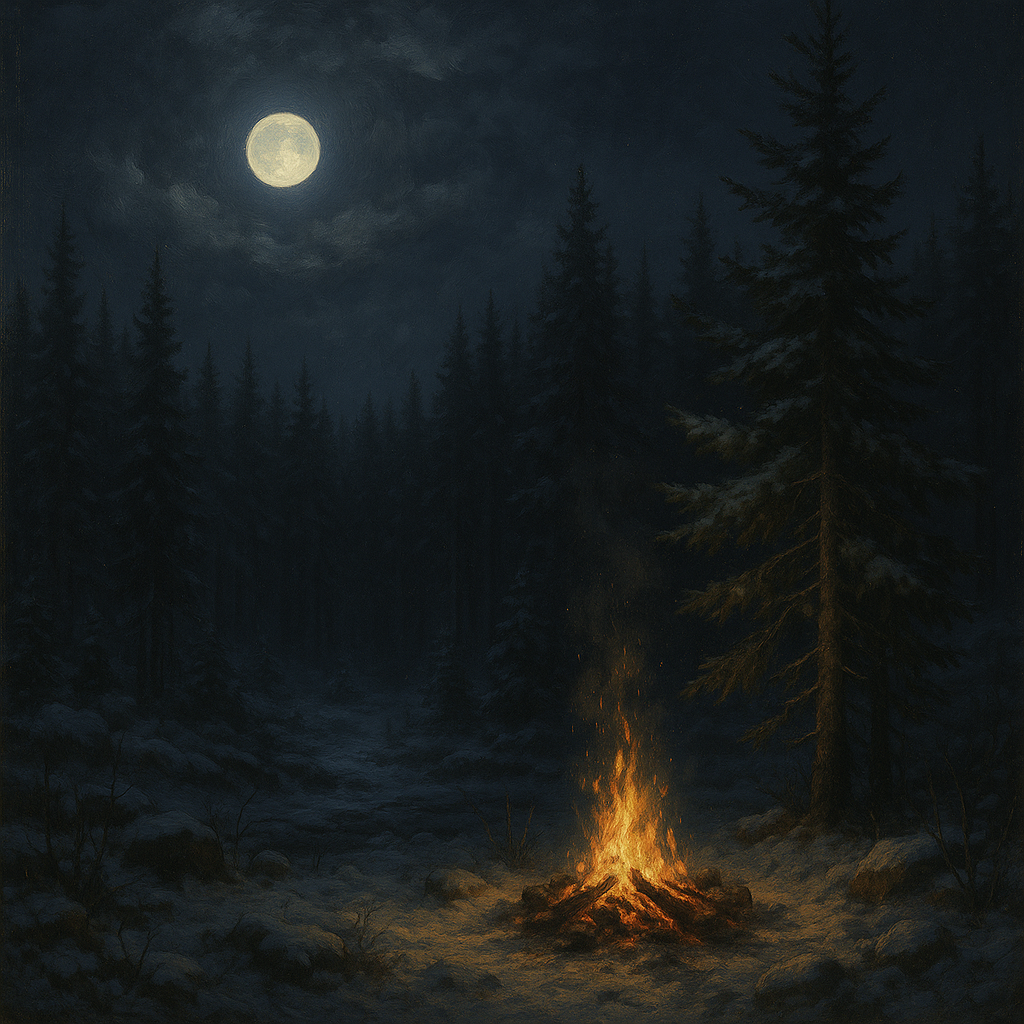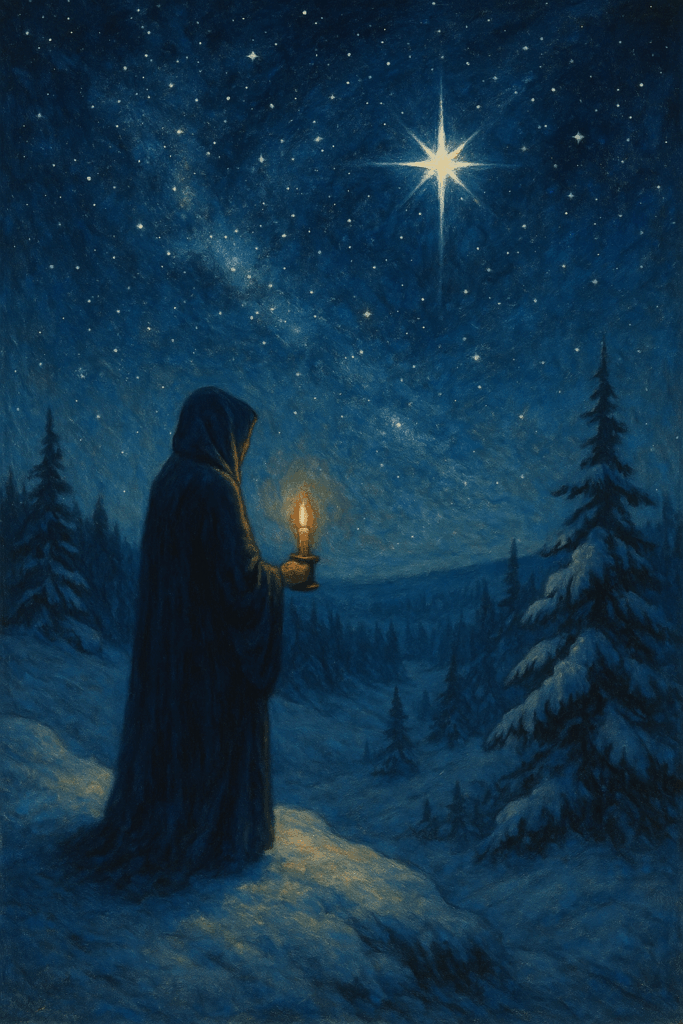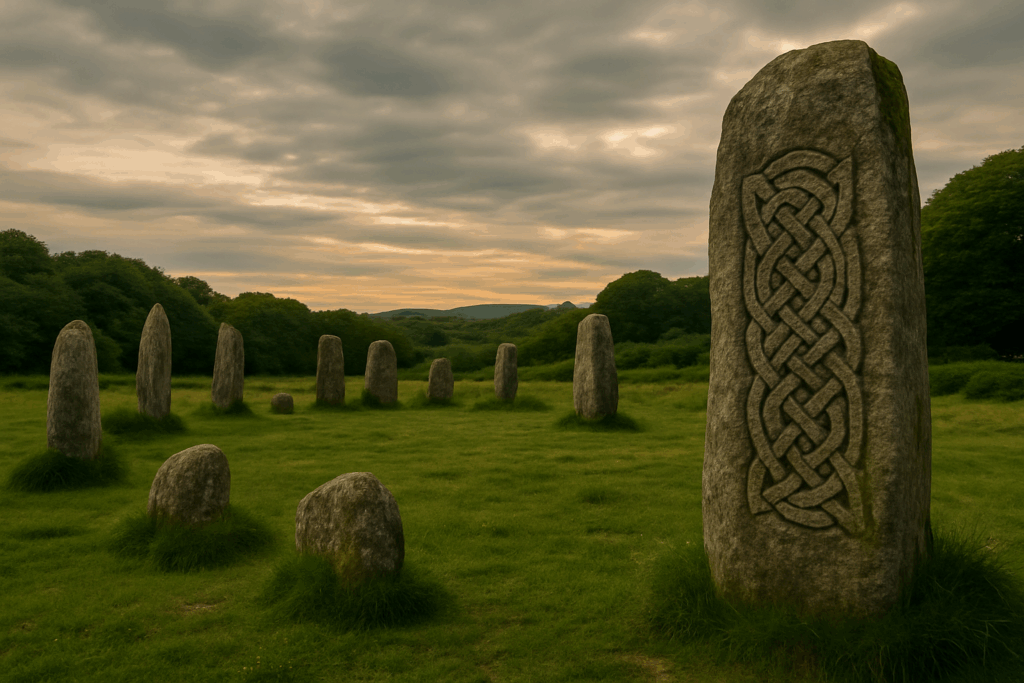🌑 November 4 – Beneath the Frost Moon

Full Moon reflections and scrying for the coming winter.
The night deepens into stillness. Frost glimmers on the blades of grass like a thousand small mirrors, and the air carries a clarity that seems to make even thought shimmer. Overhead, the Frost Moon rises — round and luminous, its light a cold blessing cast upon the turning world. This is the first full moon after Samhain, the lunar lantern that illuminates November’s hush. It is not a fiery or exuberant moon, but one of reflection and revelation, of seeing what lies hidden beneath the thin ice of the soul. Beneath the Frost Moon we enter the season of inner sight — when silence speaks, when vision ripens in the dark.
The Frost Moon has been known by many names: the Beaver Moon, the Mourning Moon, the Snow Moon of the old Celtic calendar. It marks the true beginning of winter’s descent, the gathering of cold and contemplation. The fields have been stripped, the trees stand bare, and what remains glimmers in crystalline simplicity. This moon teaches us to see through clarity, not abundance — to find beauty not in the lushness of summer, but in the elegant austerity of what remains. The world has pared itself down to essentials, and so must we. As the Frost Moon rises, it invites us to shed illusions and gaze into the deep mirror of our own being.
The practice of scrying — of gazing into reflective surfaces to receive insight — has ancient roots stretching through many cultures. The Celts looked into still water, the Greeks into polished bronze, the magicians of the Renaissance into crystal spheres. But the true art of scrying is not about conjuring visions of the future; it is about learning to see what is already there, hidden beneath the ripples of our ordinary perception. The Frost Moon, in her cold brilliance, is the perfect companion for such work. Her light, silver and unwavering, pierces illusion like a blade. Beneath her gaze, shadows reveal their contours. This is the night to sit in quiet reflection, to hold a bowl of water, a mirror, or even a windowpane glazed with frost, and let the mind grow still. The reflections that surface may not be literal images, but intuitions — feelings, symbols, whispers from the soul’s deeper layers.
To scry beneath the Frost Moon is to enter dialogue with both the outer and inner worlds. The moon’s light illuminates the frost on the ground — delicate, transient, fleeting — reminding us that all revelation is like breath upon glass. We see, and then it melts. The message of this moon is impermanence: clarity comes and goes like moonlight through clouds, but what we glimpse, we carry. The insights of this night are not for display but for planting — quiet seeds that will germinate in the dark months ahead. Write down what you see or sense. Even a fleeting image — an animal’s shape, a word, a shimmer of emotion — may carry meaning that unfolds with time.
This moon also serves as a mirror of self-honesty. It asks what you have carried unnecessarily into the new season, what fears have hardened like frost around the heart. Under her light, these crystallized emotions can be named, acknowledged, and then gently dissolved. The Frost Moon teaches compassion through clarity — to see ourselves not with harshness, but with the clean light of understanding. Just as frost outlines every branch and blade in sharp beauty, so too does this moon outline the truth of our lives, revealing both the scars and the splendor. To scry beneath her is to reclaim sight unclouded by illusion, to honor the nakedness of being.
In the ancient imagination, the Frost Moon was the watchful eye of the goddess of winter — in Celtic lore, the Cailleach, the old one whose breath brings snow. She is the great weaver of the dark season, spinning the threads of destiny while the world sleeps. To honor her beneath the Frost Moon is to embrace the wisdom of stillness, to recognize that dormancy is not death but gestation. The Cailleach’s gift is endurance — the knowledge that life persists even when hidden under layers of cold and silence. When you gaze into the mirror tonight, imagine her presence beside you: a figure robed in ice, eyes bright as stars, whispering truths that cannot be heard in the noise of summer. Ask her what you most need to know to walk through the winter with grace. Listen. The answer will come not in thunder but in quiet certainty.
There is also deep magic in the act of simply walking beneath the Frost Moon. Bundle yourself in warmth and step outside into the night. Notice the sound of your breath in the cold air, the crunch of frost beneath your feet. The moonlight will cast your shadow long and pale upon the earth — a reminder that even in darkness, you are part of the dance of light. If you pause and gaze up, you may feel a strange familiarity, as if countless generations before you have stood in this same silver glow. And indeed they have. The Frost Moon is one of humanity’s oldest companions, its light carrying the memories of every November since time began. To walk beneath it is to walk with them — the ancestors who once marked this night by fire and song, whose bones rest beneath the same earth that reflects her light.
This night, too, is an invitation to cleanse and to bless. As frost purifies the land, so the moonlight can purify the spirit. Place a bowl of water outside to absorb her light — a simple moon-water blessing for clarity and intuition. In the morning, use it to anoint your forehead, your hands, your heart, saying quietly, “I carry the moon’s sight within me.” This act is both symbolic and real, for intention charges the simplest gestures with meaning. The Frost Moon blesses those who honor silence, who are unafraid to look inward, who find truth in the still mirror of night.
Spiritually, this moon marks the beginning of the winter’s inward journey. Where Samhain opened the gates to the ancestors, the Frost Moon closes them gently, leaving us with what has been learned. It is a time of integration — to take the wisdom gathered from the liminal days and let it settle into the bones. The light of this moon does not invite action, but reflection. It does not demand, but reveals. It asks: what truth have you avoided seeing? What clarity awaits in stillness? It is a mirror of both accountability and mercy, showing not only who you have been but who you may yet become.
As the night deepens, you may notice how frost catches the moonlight, making the world sparkle like glass. This shimmer is a reminder that even in coldness, beauty persists. The Frost Moon’s lesson is that light and cold are not enemies, but companions — that clarity is born from contrast, warmth from the awareness of chill. When we can see ourselves clearly, without embellishment or fear, we rediscover our own strength. We remember that we, too, are luminous, capable of reflecting the divine light even through the frozen seasons of our lives.
When the Frost Moon finally sinks toward dawn, she leaves behind a landscape changed not in substance, but in perception. The world seems sharper, quieter, more real. The same is true within us. We awaken from her gaze seeing more truly, feeling more deeply. Her gift is not comfort but revelation — the kind of beauty that chills the heart awake.
So sit beneath her tonight, or gaze upon her through your window. Let her silver light touch your face. Feel her presence not as distance, but as intimacy — for in her glow, the boundary between the cosmic and the personal dissolves. You are part of her light, and she is part of your seeing. Beneath the Frost Moon, everything reflects everything else. All is still. All is luminous. All is alive.


